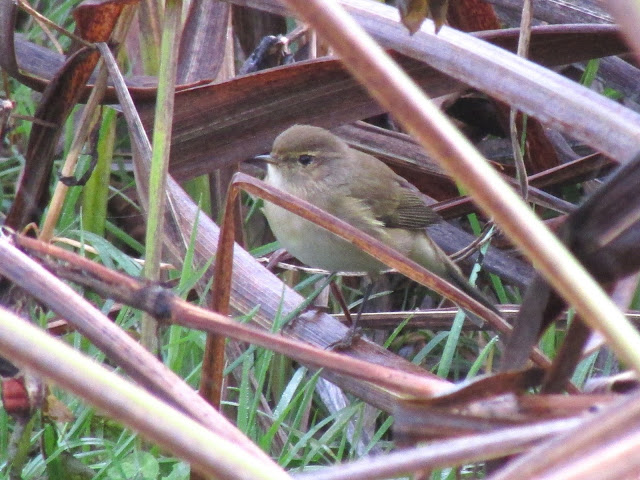Sewage plants and wetlands
Chiffchaffs are insectivorous year round, so they can't rely on garden feeding like Blackcaps during winter. Overwintering in Chiffchaffs was documented in the early 19th century, but this seem to involve very few birds. In recent decades, however, there seem to have been an increase in numbers, possibly aided by global warming. Ringing and recaptures have allowed estimates of around 100 individuals gathering in suitable sites. Chiffchaff winter survival depends on a steady supply of invertebrates (mainly midges, gnats and aphids) and sheltered sites where to roost. They appear to survive several consecutive nights with frost, so the increased temperatures may have more important effects on insect abundance, not actual survival of the birds. Suitable habitats include sheltered coastal areas, but they also use urban and suburban sites, especially near water, sewage treatment plants (where warmer water means an abundance of insects) woodlands and hedgerows. The Chiffchaff on the top shot, fed low on the marginal vegetation around an urban lake, East Park, Hull on 2/12/2013.
It's complicated...
The Chiffchaff is part of a species complex and its taxonomy has changed quite a lot in recent years. What was considered a single species now includes the Canarian and Iberian Chiffchaff, previously races now elevated to species level. The Chiffchaff proper is now divided into various races: the nominal race, collybita, breeds in the UK, whereas tristis or Siberian Chiffchaff, and Scandinavian Chiffchaff abietinus. The three races are very similar, differing in the tone of the plumage and subtle morphological features, and more notably, song and calls. Given this and the occurrence of intermediate forms between some of the species makes them very difficult to identify in the field.
Residents, migrants and winter visitors
It appears that the bulk of the UK breeding population of Chiffchaffs, belonging to the subspecies collybita, migrate south in the winter. In addition, there is very strong passage through the UK, especially in the autumn, mainly of northern European birds moving to winter quarters in the Iberian Peninsula, and Northern and Western Africa and these include a sprinkling of abietinus and tristis individuals. What about the winter birds? Where do they come from?
Ringing and DNA analysis
Ringing recaptures in the winter don't include locally breeding Chiffchaffs, suggesting that the winter birds are also migrants. Most of them appear to belong to the collybita subspecies, which breeds in western Europe and Southern Scandinavia. Recoveries of birds ringed in winter in Southern England have been made subsequently in N England and Denmank during the breeding season. Recently, DNA analysis has come to the rescue. It is possible to obtain enough material for DNA analysis from tiny feathers, dislodged when ringing birds. Sending these feathers for DNA analysis allows to discriminate between subspecies, as they have distinct DNA. Individuals captured in the south of England include some Siberian chiffchaffs confirmed by DNA. Over 20% of ringed wintering Chiffchaffs in a mixed woodland by a lough in Ireland was confirmed to be tristis and two individuals were confirmed as abietinus. So it appears that wintering Chiffchaffs include individuals from all three European subspecies, that once finding suitable locations during migration they settle for a while to feed. Ringing recaptures have found the same individuals wintering repeated years in the same location. Another intriguing feature of wintering Chiffchaffs is that males, which are larger than females, were the bulk of wintering chiffchaffs in the past, although females are increasingly wintering. There is still so much to learn on Chiffchaff migration, taxonomy and evolution.
More information
Clement, P. 1995. The Chiffchaff. Hamlyn Species Guides. pp126.
Clement, P., Helbig, A. J. and Small, B. 1998. Taxonomy and identification of chiffchaffs in the Western Palearctic. Br. Birds 91, 361–375.
Birds in Cheshire and the Wirral. A breeding and wintering atlas. Wintering Chiffchaffs.
O’Mahony, B., Farrer, D. and Collinson, M. 2008. Genetic identity of wintering Common Chiffchaffs Phylloscopus collybita trapped in County Kerry in 2015. Ir. Birds
Ray Meads Ringing Group A review of our wintering chiffchaffs.
Simms, E. 1985. British Warblers. The New Naturalist Series. Collins. 432 pp.
Simms, E. 1985. British Warblers. The New Naturalist Series. Collins. 432 pp.


Many thanks, very interesting. We had a wintering Chiffchaff actually singing in Hyde Park on a sunny day recently.
ReplyDelete